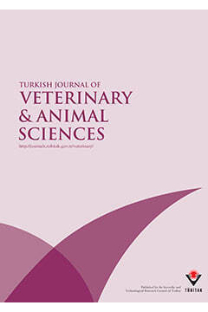Influence of feeding frequency on feed intake, growth performance and nutrient utilization in European sea bass (Dicentrarchus labrax) fed pelleted of extruded diets
Pelet ve ekstrude yemlerle beslenen levrek balığında (Dicentrarchus labrax) yemleme sıklığının yem tüketimi, büyüme performansı ve nutrient kullanımı üzerine etkileri
___
- 1. De Silva, S.S., Anderson, T.A.: Fish Nutrition in Aquaculture. Aquaculture Series, Chapman & Hall, London. 1995.
- 2. Houlihan, D., Boujard, T., Jobling, M.: Food Intake in Fish. Blackwell Science, Oxford, 2001.
- 3. Tekinay, A.A., Davies, S.J.: Dietary carbohydrate level influencing feed intake, nutrient utilisation and plasma glucose concentration in the rainbow trout, (Oncorhynchus mykiss Walbaum, 1792). Turk. J. Vet. Anim. Sci., 2001; 25: 657-666.
- 4. Ballestrazzi, R., Lanari, D., D'Agaro, E.: Performance, nutrient retention efficiency, total ammonia and reactive phosphorus excretion of growing European sea-bass (Dicentrarchus labrax, L.) as effected by diet processing and feeding level. Aquaculture, 1998; 161:55-65.
- 5. Tekinay, A.A.: Dietary interactions influencing feed intake, nutrient utilisation and appetite regulation in thd rainbow trout, Oncorhynchus mykiss. Ph.D. Thesis, University of Plymouth, UK. 1999.
- 6. Kubitza, F., Lovshin, L.L.: Formulated diets, feeding strategies, and cannibalism control during intensive culture of juvenile carnivorous fishes. Rev. in Fish. Sci, 1999; 7: 1-22.
- 7. Lee, S-M., Cho, S.H., Kim, D-J.: Effects of feeding frequency and dietary energy level on growth and body composition of juvenile flounder, Paralichthys olivaceus (Temminck & Schlegel). Aquacult. Res., 2000:31:917-921.
- 8. Dwyer, K.S., Brown, J.A., Parrish, C, Lall, S.P.: Feeding frequency affects food consumption, feeding pattern and growth of juvenile yellowtail flounder (Limanda ferruginea). Aquaculture, 2002:213:279-292.
- 9. Goddard, S.: Feed Management in Intensive Aquaculture. Chapman & Hall, New York. 1996; 194 pp.
- 10. Lee, S-M., Hwang, U.G., Cho, S.H.: Effects of feeding frequency and dietary moisture content on growth, body composition and gastric evacuation of juvenile Korean rockfish (Sebastes schlegeli). Aquaculture, 2000; 187: 399-409.
- 11. Andrews, J.W., Page, J.W.: The effects of frequency of feeding on culture of catfish. Trans. Am. Fish.Soc, 1975; 104:317-321.
- 12. Jarboe, H.H., Grant, W.J.: The influence of feeding time and frequency on the growth, survival, feed conversion, and body composition of channel catfish, Ictalurus punctatus, cultured in a three-tier, closed, recirculating raceway system. J. Appl. Aquacult, 1997; 7: 43-52.
- 13. Grayton, B.D., Beamish, F.W.H.: Effects of feeding frequency on food intake, growth and body composition of rainbow trout (Salmo gairdneri). Aquaculture, 1977; 11: 159-172.
- 14. Tsevis, N., Klaoudatos, S., Conides, A.: Food conversion budget in sea bass, Dicentrarchus labrax, fingerlings under two different feeding frequency patterns. Aquaculture, 1992; 101: 293-304.
- 15. Mihelakakis, A., Yoshimatsu, T., Tsolkas, C: Effects of feeding frequency on growth, feed efficiency and body composition in young common pandora. Aquacult. Int., 2001; 9: 197-204.
- 16. FAO Fishery Information, Data and Statistics Unit: Aquaculture Production 2002. FAO yearbook, Fishery statistics, Capture production. Vol. 94/2 Rome/Roma, FAO. 2004.
- 17. AOAC International: Official Methods of Analysis of A0AC International, 17th ed. AOAC, Arlington, VA, USA, 2000
- 18. Brett, J.R., Groves, T.D.D.: Physiological energetics. In: Fish Physiology (Hoar, W.S., Randall, D.J. and Brett, J.R. eds), 1979; Vol. 8:280-351.
- 19. Zar, J.H.: Biostatistical Analysis. Fourth edition. Prentice-Hall, Inc., Upper Saddle River, NJ. 931 pp., 2001.
- 20. Tekinay, A.A., Davies, S.J., Güner, Y.: Growth, feed utilization and carcass composition in rainbow trout fed diets with a similar digestible energy content and different carbohydrate levels. Isr. J. Aquacult. Bamidgeh, 2003; 55: 123-131.
- 21. Ballestrazzi, R., Lanari, D.: Growth, body composition and nutrient retention efficiency of growing sea-bass (Dicentrarchus labrax, L.) fed fish oil or fatty acid Ca salts. Aquaculture, 1996; 139: 101-108.
- 22. Ballestrazzi, R., Lanari, D., Tulli, E., Tibaldi, E.: Effects of fatty acids Ca salts on the performances and the body composition of sea bass (Dicentrarchus labrax, L.) fingerlings. Riv. Ital. Acquacol., 1992:27:91-103.
- 23. Peres, H., Oliva-Teles, A.: Influence of temperature on protein utilization in juvenile European seabass (Dicentrarchus labrax). Aquaculture, 1999; 170: 337-348.
- 24. Boujard, T., Gelineau, A., Coves, D., Corraze, G., Dutto, G., Gasset, E., Kaushik, S.J.: Regulation of feed intake, growth, nutrient and energy utilisation in European sea bass (Dicentrarchus labrax) fed high fat diets. Aquaculture, 2004; 231: 529-545.
- 25. Deguara, S.: Evaluation of different pressed and extruded fish meal based diets on the growth of gilthead sea bream, Sparus aurata L. Cah. Options Mediterr., 1997; 22: 123-139.
- 26. Wang N., Hayward, R.S., Noltie, D.B.: Effect of feeding frequency on food consumption, growth, size variation, and feeding pattern of age-0 hybrid sunfish. Aquaculture, 1998; 165: 261-267.
- 27. Lanari, D., Poli, B.M., Ballestrazzi, R., Lupi, P., D'Agaro, E., Mecatti, M.: The effects of dietary fat and NFE levels on growing European sea bass (Dicentrarchus labrax L). Growth rate, body and fillet composition, carcass traits and nutrient retention efficiency. Aquaculture, 1999; 179: 351-364. 28. Perez, L, Gonzalez, H., Jover, M., Fernandez-Carmona, J.: Growth of European sea bass fingerlings (Dicentrarchus labrax) fed extruded diets containing varying levels of protein, lipid and carbohydrate. Aquaculture, 1997; 156: 183-193.
- 29. Shearer, K.D.: Factors affecting the proximate composition of cultured fishes with emphasis on salmonids. Aquaculture, 1994; 119:63-88.
- 30. Lupatsch, I., Kissil, G.W., Sklan, D.: Optimization of feeding regimes for European sea bass Dicentrarchus labrax: a factorial approach. Aquaculture, 2001; 202: 289-302.
- ISSN: 1300-0128
- Yayın Aralığı: 6
- Yayıncı: TÜBİTAK
Mete YANAR, Olcay GÜLER, Bahri BAYRAM, Jale METİN
Bayşu Nalan SÖZBİLİR, Ömer UÇAR, Yavuz ÖZTÜRKLER, Şaban MARAŞLI
New pelagic gastropoda species encountered on the Tuekish coast of the Levant Sea
Cem ÇEVİK, Deniz ERGÜDEN, Benin TOKLU, Ercan SARIHAN, Ahmet KIDEYS
Süheyla TÜRKYILMAZ, Kenan TÜRKYILMAZ, Osman KAYA
Plasma Ascorbic Acid Levels in Lambs With Coccidiosis
Şima ŞAHİNDURAN, Kenan SEZER, Tülay BÜYÜKOĞLU, Bayram Ali YUKARI, Metin Koray ALBAY
Serological Detection of Listeriosis at a Farm
Mehmet Kazım BÖRKÜ, Kerem URAL, Serkal GAZYAĞCI, Yunusemre ÖZKANLAR, Cahit BABÜR, Selçuk KILIÇ
In vitro effects of prostaglandin F2 $alpha$ and metamizol on the motility of diluted bull semen
